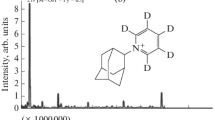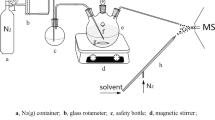Abstract
Nowadays most LC-MS methods rely on tandem mass spectrometry not only for quantitation and confirmation of compounds by multiple reaction monitoring (MRM), but also for the identification of unknowns from their product ion spectra. However, gas-phase reactions between charged and neutral species inside the mass analyzer can occur, yielding product ions at m/z values higher than that of the precursor ion, or at m/z values difficult to explain by logical losses, which complicate mass spectral interpretation. In this work, the formation of adduct ions in the mass analyzer was studied using several mass spectrometers with different mass analyzers (ion trap, triple quadrupole, and quadrupole-Orbitrap). Heterocyclic amines (AαC, MeAαC, Trp-P-1, and Trp-P-2), photo-initiators (BP and THBP), and pharmaceuticals (phenacetin and levamisole) were selected as model compounds and infused in LCQ Classic, TSQ Quantum Ultra AM, and Q-Exactive Orbitrap (ThermoFisher Scientific) mass spectrometers using electrospray as ionization method. The generation of ion-molecule adducts depended on the compound and also on the instrument employed. Adducts with neutral organic solvents (methanol and acetonitrile) were only observed in the ion trap instrument (LCQ Classic), because of the ionization source on-axis configuration and the lack of gas-phase barriers, which allowed inertial entrance of the neutrals into the analyzer. Adduct formation (only with water) in the triple quadrupole instruments was less abundant than in the ion trap and quadrupole-Orbitrap mass spectrometers, because of the lower residence time of the reactive product ions in the mass analyzer. The moisture level of the CID and/or damper gas had a great effect in beam-like mass analyzers such as triple quadrupole, but not in trap-like mass analyzers, probably because of the long residence time that allowed adduct formation even with very low concentrations of water inside the mass spectrometer.

ᅟ





Similar content being viewed by others
References
Weisz A, Andrzejewski D, Fales HM, Mandelbaum A. Attachment of neutrals during tandem mass spectrometry of sulfonic acid dyes and intermediates in an ion trap. J Mass Spectrom. 2002;37:1025–33.
Sultan J. Collision induced dissociation of deprotonated guanine: fragmentation of pyrimidine ring and water adduct formation. Int J Mass Spectrom. 2008;273:58–68.
Chan C, Axe FU, Bolgar M, Attygalle AB. Reactivity of gaseous sodiated ions derived from benzene dicarboxylate salts toward residual water in the collision gas. J Mass Spectrom. 2010;45:1130–8.
Guan Z, Liesch JM. Solvation of acylium fragment ions in electrospray ionization quadrupole ion trap and Fourier transform ion cyclotron resonance mass spectrometry. J Mass Spectrom. 2001;36:264–76.
Kölliker S, Oehme M, Merz L. Unusual MSn fragmentation patterns of 2,1-dinitro-phenylhydrazine and its propanone derivative. Rapid Commun Mass Spectrom. 2001;15:2117–26.
Toribio F, Moyano E, Puignou L, Galceran MT. Multistep mass spectrometry of heterocyclic amines in a quadrupole ion trap mass analyzer. J Mass Spectrom. 2002;37:812–28.
Tuytten R, Lemière F, Esmans EL, Herrebout WA, Van Der Veken BJ, Dudley E, et al. In-source CID of guanosine: gas phase ion-molecule reactions. J Am Soc Mass Spectrom. 2006;17:1050–62.
Tuytten R, Lemière F, Van Dongen W, Esmans EL, Witters E, Herrebout W, et al. Intriguing mass spectrometric behavior of guanosine under low energy collision-induced dissociation: H2O adduct formation and gas-phase reactions in the collision cell. J Am Soc Mass Spectrom. 2005;16:1291–304.
Lee SK, Kim HJ, Jin C, Lee J. Formation of the unusual [M + H – 11 Da]+ ion peak in the collision-induced dissociation mass spectrum of [M + H]+ ion of hydrochlorothiazide. J Mass Spectrom. 2009;44:1538–41.
Chander CP, Raju G, Mathai G, Srinivas R, Gaikwad HK, Bantu R, et al. Electrospray ionization tandem mass spectrometry of 3-phenyl-N-(3-(4-phenylpiperazin-1-yl)propyl)-1H-pyrazole-5-carboxamide derivatives: unusual fragmentation involving loss of 11 u. Rapid Commun Mass Spectrom. 2012;26:207–14.
Neta P, Godugu B, Liang Y, Simón-Manso Y, Yang X, Stein SE. Electrospray tandem quadrupole fragmentation of quinolone drugs and related ions. On the reversibility of water loss from protonated molecules. Rapid Commun Mass Spectrom. 2010;24:3271–8.
Liang Y, Neta P, Simón-Manso Y, Stein SE. Reaction of arylium ions with the collision gas N2 in electrospray ionization mass spectrometry. Rapid Commun Mass Spectrom. 2015;29:629–36.
Attygalle AB, Kharbatia N, Bialecki J, Ruzicka J, Svatos A, Stauber EJ. An unexpected ion-molecule adduct in negative-ioncollision-induced decomposition ion-trap mass spectra of halogenated benzoic acids. Rapid Commun Mass Spectrom. 2006;20:2265–70.
Neta P, Farahani M, Simón-Manso Y, Liang Y, Yang X, Stein SE. Unexpected peaks in tandem mass spectra due to reaction of product ions with residual water in mass spectrometer collision cells. Rapid Commun Mass Spectrom. 2014;28:2645–60.
Beuck S, Schwabe T, Grimme S, Schlörer N, Kamber M, Schänzer W, et al. Unusual mass spectrometric dissociation pathway of protonated isoquinoline-3-carboxamides due to multiple reversible water adduct formation in the gas phase. J Am Soc Mass Spectrom. 2009;20:2034–48.
Thevis M, Kohler M, Schlörer N, Schänzer W. Gas phase reaction of substituted isoquinolines to carboxylic acids in ion trapand triple quadrupole mass spectrometers after electrospray ionization and collision-induced dissociation. J Am Soc Mass Spectrom. 2008;19:151–8.
Barceló-Barrachina E, Moyano E, Puignou L, Galceran MT. Evaluation of different liquid chromatography-electrospray mass spectrometry systems for the analysis of heterocyclic amines. J Chromatogr A. 2004;1023:67–78.
Acknowledgments
The authors acknowledge financial support received from the Spanish Ministry of Economy and Competitiveness under the project CTQ2012-30836, and from the Agency for Administration of University and Research Grants (Generalitat de Catalunya, Spain) under the project 2014 SGR-539. The authors also acknowledge Dr. Josep Caixach’s assistance with the Exactive mass spectrometer.
Author information
Authors and Affiliations
Corresponding author
Ethics declarations
Conflict of interest
The authors declare that they have no conflict of interest.
Electronic supplementary material
Below is the link to the electronic supplementary material.
ESM 1
(PDF 50 kb)
Rights and permissions
About this article
Cite this article
Alechaga, É., Moyano, E. & Galceran, M.T. Ion-molecule adduct formation in tandem mass spectrometry. Anal Bioanal Chem 408, 1269–1277 (2016). https://doi.org/10.1007/s00216-015-9237-6
Received:
Revised:
Accepted:
Published:
Issue Date:
DOI: https://doi.org/10.1007/s00216-015-9237-6




